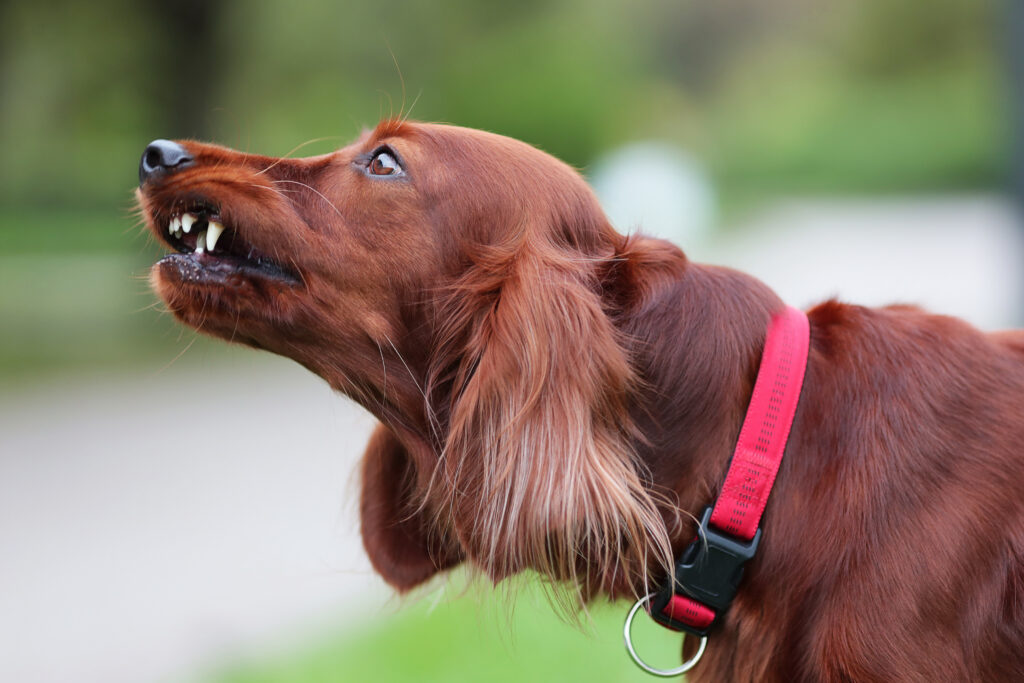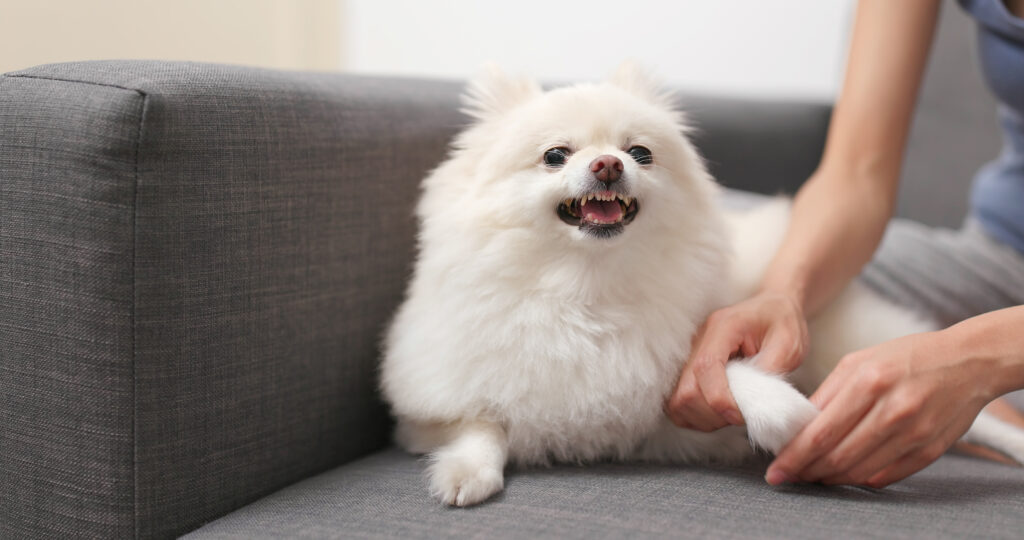Learning dog body language can be overwhelming for beginners. If your dog growls when being petted, you might get scared and wonder what it is you’re doing wrong.
If your dog growls when you pet them, they’re likely saying “no.” It’s important to respect their boundaries and stop. However, dogs can also growl out of fear, pain, or happiness. Happy growls typically sound different, and your dog will display other happy body language.
Any sudden change in behavior, such as growling when your dog didn’t use to, can be a symptom of pain or illness. In this case, it’s important to see a veterinarian.
In this article, we’ll discuss why dogs growl when you pet them and what you should do about it.
Reasons Dogs Growl When You Pet Them

Feral dogs or those not socialized to humans might also growl out of fear.
©Bonsales/Shutterstock.com
Fear
Especially if you have a new dog or one who has experienced abuse, they might recoil and growl when touched. Feral dogs or those not socialized to humans might also growl out of fear.
Other signs of fear include cowering, pulling away, baring their teeth, rolling over to show their stomach, wagging their tail, tail lowered between the legs, and whale eyes (when the whites of the eyes are showing).
Warning Growls
Warning growls might sound scary, but it’s really just your dog saying “no.” If your dog gives a warning growl when being pet, it doesn’t mean they’ll bite–especially not if you respect their boundaries.
It might mean they don’t want to be petted at all, or you touched them somewhere they dislike being touched.
Never punish or ignore a warning growl (unless strictly necessary, such as when providing medical care). We want our dogs to be able to say no, and punishing communication makes them less likely to communicate with us in the future.
This can lead to a dog who goes straight to biting because they don’t feel it’ll be listened to otherwise.
Happy Growls

We want our dogs to be able to say no, and punishing communication makes them less likely to communicate with us in the future.
©Irina Nedikova/Shutterstock.com
Some dog breeds are more vocal than others and will growl even when happy! This might be super confusing for you–after all, how do you tell the difference?
The key, in this case, is to observe your dog’s other body language. Are they rolled over for tummy rubs, their body lose and relaxed in your lap? This is a sign of a happy pup!
Context is also important. For instance, many dogs will grunt, groan, and growl when you’re scratching a good spot, like their ears or butt. They’ll continue leaning into your hand, indicating they want more, and it feels nice!
Most times, these growls sound different from a warning growl. However, this isn’t always the case, so you should also pay attention to your dog’s body language.
It’s important to know dog body language, both in general and how it presents in your dog. Every individual is different, but for the most part, their body language will be similar.
Injury or Illness
Your dog might not want to be touched if it is hurt or sick. They might growl when you touch a certain part of their body because it hurts or just be more irritable in general.
If growling is unusual for your dog, a trip to the vet is a must. Any behavioral change like this can indicate that something’s wrong, so a good check-up is needed to rule that out.
It’s not Dominance

It’s important to know dog body language, both in general and how it presents in your dog.
©leungchopan/Shutterstock.com
One thing’s for sure–your dog isn’t trying to be the “alpha” or the pack’s leader. Their growling isn’t disrespectful toward you or a challenge.
Though some people will claim this, it’s actually a very outdated view of dogs and their social dynamics. Thinking this way is detrimental to your dog and your relationship with them and can also be dangerous.
The dominance theory of dog training has been shown to increase fearfulness and aggression. Often, the suggested methods are abusive toward the dog.
I recommend avoiding aversive training methods and looking into force-free ones if you aren’t using them already.
Checking for Consent is Key
When petting any dog, you should always ensure that they opt-in and want to be touched. Just like humans sometimes want to be left alone, dogs can feel the same way.
A good habit to get into is checking for consent before and while you pet or cuddle a dog. You can do this by offering your hand or even giving a cue. I like holding my hand out and asking, “do you want to be petted?”
This gives my dogs a chance to come to me if they want or to continue what they’re already doing if not.
While petting or snuggling your dog, you can stop, pull away, and gauge their body language. Are they pawing at your hand or nudging it to get you to pet them again? Or do they seem more relaxed now that you’ve stopped?
Is it Okay to Let Your Dog Growl?
It’s not only okay but encouraged and necessary to let your dog growl. Growling is your dog communicating with you and saying, “no, I don’t like that.”
Your dog should be able to set boundaries and have them upheld. A lack of this can lead to them feeling insecure and frustrated.
It’s important to teach everyone in your dog’s life to uphold their boundaries, including guests, children, and other animals.
Learning about other uncomfortable body language signs, such as whale eye or stiffening when pet, is another way to make your dog more comfortable. You might even be able to pull away before they growl.
Punishing communication at this stage can lead to your dog skipping the growl next time. They might snarl, nip, or bite. Dogs can become aggressive but otherwise wouldn’t because they have no other option. The humans in their lives are not listening to them, so they have to take extreme measures to get their point across.
Should I be Worried if My Dog Growls at Me?

Not every dog who growls will escalate to a bite.
©Soloviova Liudmyla/Shutterstock.com
Growling is many steps away from biting for most dogs. Just like every human that says “no” isn’t going to escalate to punching someone, not every dog who growls will escalate to a bite.
You don’t need to worry if your dog growls at you, other pets, or people. It’s a good thing that they feel safe to express their feelings, and it gives you a chance to change the situation before your dog escalates.
Dogs who don’t growl before resorting to aggression are actually more dangerous, as their cues are more subtle. Often dogs who are seen to bite “out of nowhere” were actually trained not to show their discomfort through punishment or via people ignoring their growls.
It is important to listen to your dog whenever possible, though–a growl can mean your dog is getting fed up and may bite if not listened to.
And even if they won’t bite–they might be saying they don’t consent to being pet anymore. The right thing to do is to give them space.
Final Thoughts
In conclusion, dogs can growl when you pet them for various reasons. It can be joy, especially if you’re rubbing an itchy spot, their ears, or their butt.
Your dog might be setting a boundary, growling out of fear, in pain, or sick. It’s important to pay attention to their other body language and environmental cues to determine the cause of the growling.
Remember never to punish or ignore a warning growl, as this can lead to your dog skipping the growl when communicating in the future–and resorting to more aggressive means of communication.
The photo featured at the top of this post is © Bonsales/Shutterstock.com
Ready to discover the top 10 cutest dog breeds in the entire world?
How about the fastest dogs, the largest dogs and those that are -- quite frankly -- just the kindest dogs on the planet? Each day, AZ Animals sends out lists just like this to our thousands of email subscribers. And the best part? It's FREE. Join today by entering your email below.
Thank you for reading! Have some feedback for us? Contact the AZ Animals editorial team.







